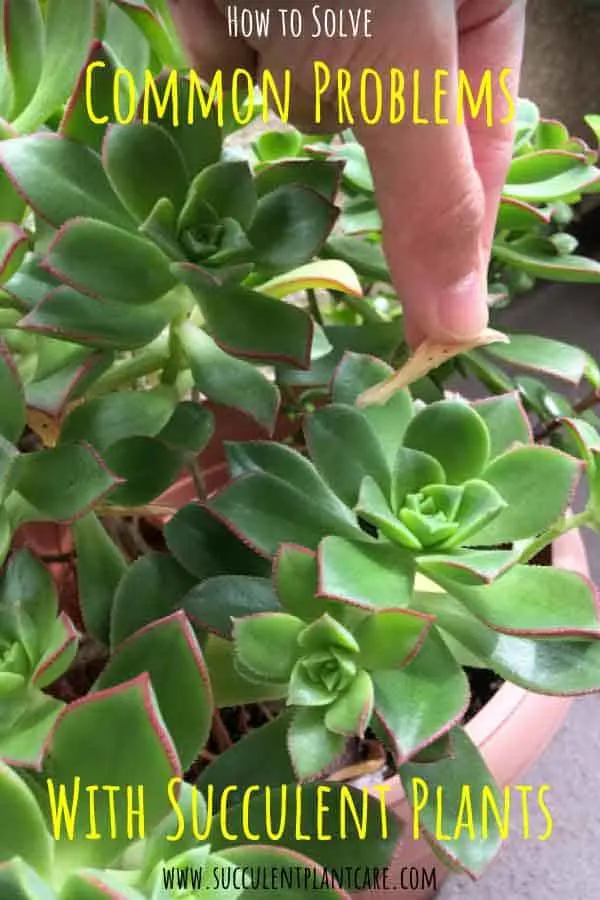Succulents are amazing plants that can withstand harsh conditions. They are prized for their beauty and unique qualities. When given the right environment, they are able to thrive for long periods of time with minimal care. They are, however, not immune to problems and can show signs that they are in need of a change.
If you are uncertain whether your succulent plant is displaying normal behavior or is signaling that there is a problem in need of immediate attention, the information below will help you troubleshoot what’s going on with your plant.
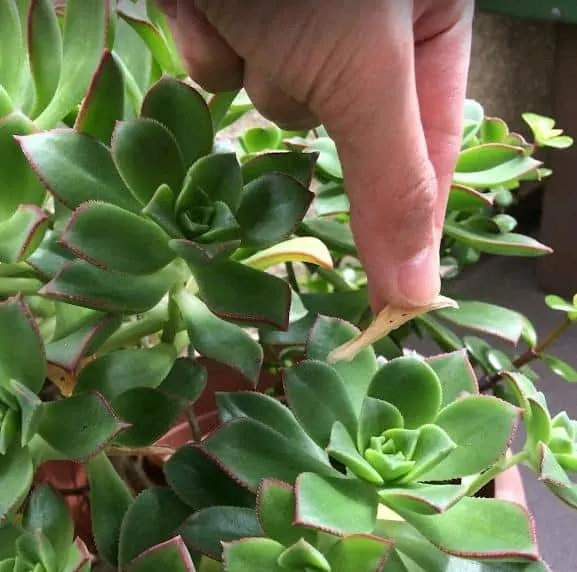
Here are Common Problems of Succulents and How to Fix Them:
Leaves falling off
Why are leaves falling off your succulents? The most common reason is watering issues. Too much water can cause the leaves to swell, become soft and mushy, and eventually fall off. Leaves that fall off from overwatering appear wet and mushy, and the stem may appear puffy.
Remedy: Withhold watering until the top inch of the soil feels dry. Make sure the potting mix is well draining and that the plant is not sitting in water for loo long. If the wrong potting mix is used, re-pot the plant and switch out the soil with a well draining one.
When repotting, let the plant dry out for a few days to recover and heal before transplanting and watering again. Let excess water drain out of the holes of the pot when watering. If the pot does not have drainage holes, consider drilling one or alter watering techniques to prevent overwatering.
Leaves can also fall off during extreme heat. During periods of intense heat or drought, succulents respond by dropping their leaves to help conserve energy and maintain their water supply. While this is a normal response in nature, there are steps you can take to minimize stress in your plant.
Remedy: Move the plant in a shadier location away from the intense, full sun during a heatwave or drought. The plant may also need to be watered more often during these conditions. Increase watering as needed or when the top inch of the soil feels dry to touch.
Yellow Leaves
Leaves turning yellow can be for different reasons:
Watering issues
Leaves can turn yellow from watering issues. Overwatering and underwatering can both cause the leaves to turn yellow. Pay attention to other things that are going on with your plant.
If the plant is well watered and the leaves are turning yellow, feel mushy and swollen, the plant is being overwatered. If they leaves are turning yellow, shriveling and wilting, and you know you have not watered your plant for a while, then the plant is most likely underwatered.
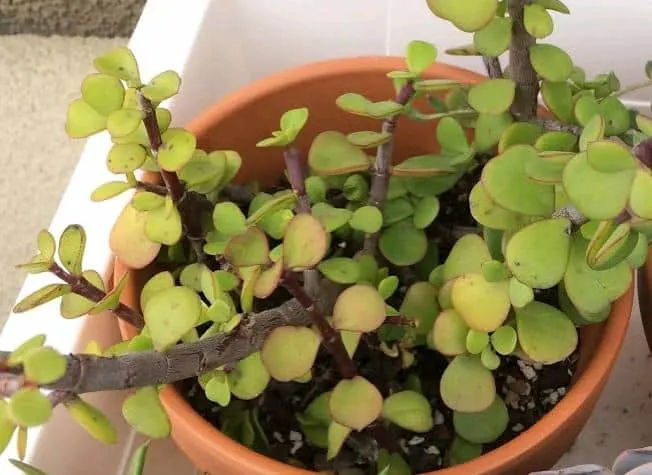
Remedy: Adjust watering techniques. If you suspect the plant is being overwatered, water less frequently and wait for the soil to dry out in between waterings. If the plant is being under watered, water the plant more thoroughly.
Most succulents like a good watering until excess water drips out of the holes of the pot. Wait until the soil dries before watering again.
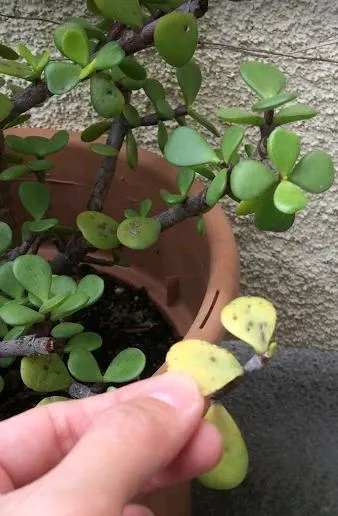
Lack of nutrients
Leaves can turn yellow from lack of nutrients. Most commercial succulent potting soil come with added compost or fertilizer in the mix. The plants can feed on those nutrients for quite some time.
Eventually these nutrients are flushed out of the soil from constant watering and nutrients need to be added back in. Nutrients can be added in by re-potting the plant in fresh potting mix or by fertilizing the plant.
Remedy: Re-pot the plant using a suitable well draining potting mix or apply fertilizer. Use a well balanced fertilizer designed for houseplants or a fertilizer blend specifically formulated for cacti and succulents.
Cacti and succulents are not heavy feeders and do not require a lot of fertilizers. Dilute the amount of fertilizer recommended on the package to half. Feeding about every two weeks during the growing season should be good enough.
Withered or Shriveled Up Leaves
Watering Issues
The main cause of shriveled leaves is underwatering. If the leaves appear withered and shriveled, often from the top leaves of the plant first, the plant is most likely in need of water. If you have been watering your plant sparingly, and the leaves are starting to shrivel, you have an under watering problem which can be easily remedied.
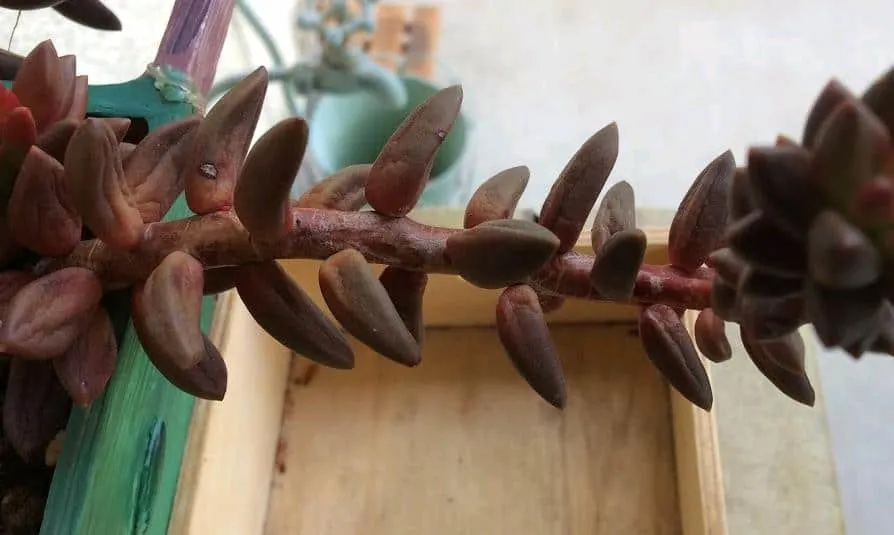
Remedy: Water plant more thoroughly and frequently. During the growing season or during a heatwave, succulents need more water. Let water drain out of the holes when watering and allow soil to dry before watering again.
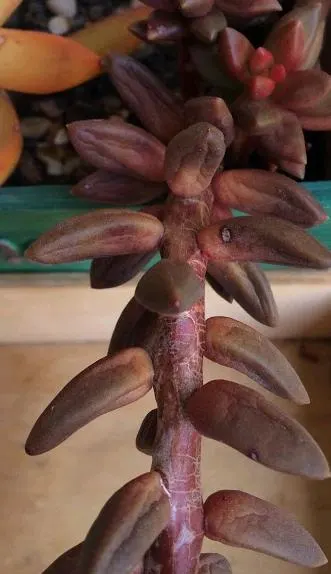
Overwatering can also cause the leaves to shrivel. But instead of a wilted, shriveled appearance leaves can appear limp, weak and fall off from too much water. The stem can also appear puffy.
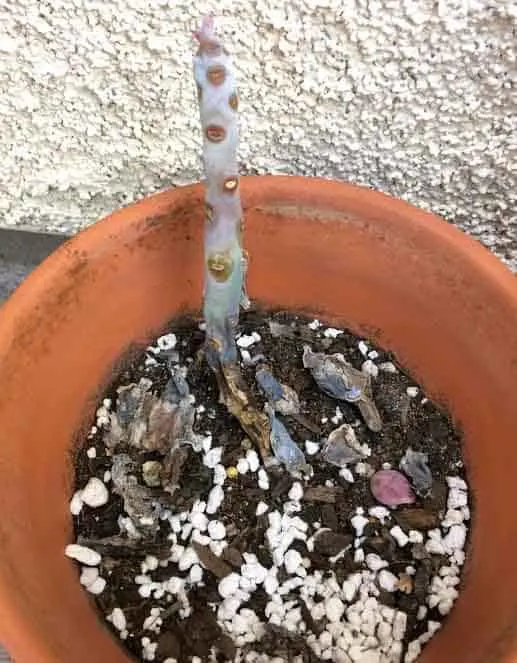
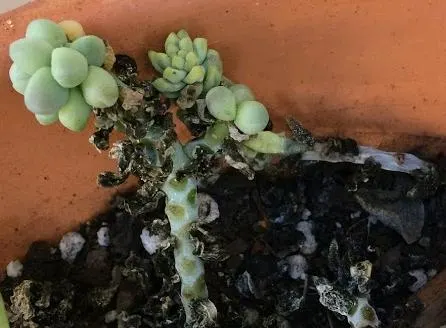
These are pictures of overwatered plants that dropped most or all of their leaves. The leaves were mushy and rotting from mold. The stems are also mushy.
Remedy: If you suspect overwatering, water less frequently and make sure you allow the soil to dry out between waterings. The top inch of the soil needs to feel dry before watering again. If the plant is in a wrong potting mix, re-pot in a well draining potting soil.
When repotting, let the plant dry out for a few days before to allow it to recover and heal from overwatering before transplanting and watering again. There are tools you can use such as moisture meters and hygrometers to check for moisture in the soil and the air. Please check out my resource page for product recommendations.
Brown Leaves or Dark Spots on Leaves
The most common reason for brown or dark spots on the leaves leaves on your succulents is sun damage or sunburn. This can happen if the plant is exposed to unfiltered full sun or if the plant is recently moved to a sunny location without acclimatizing the plant first.
Even plants that are acclimated to full sun can have brown leaves during very intense heat waves or drought.
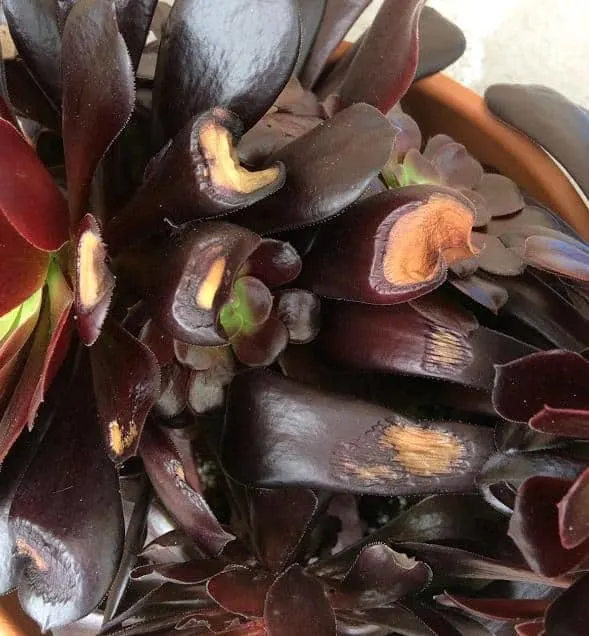
Remedy: Move the plant to a more shady location or provide more shade during a heatwave. Before moving a plant outdoors or to a sunnier location, do so by slowly increasing the amount and intensity of sun the plant receives overtime to slowly acclimatize the plant and prevent sun damage.
Do not place baby plants or newly propagated plants under full sun to avoid scorching the plants.
For product recommendations on shade cloths and outdoor sun protection for succulents, please click on my resource page.
Dead Lower Leaves
Lower leaves naturally wither and die as the plant grows and produces new leaves from the center of the plant. Dead leaves can be easily pulled off or they drop off on their own.
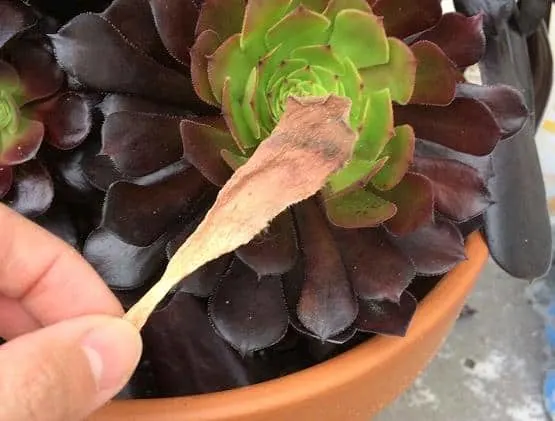
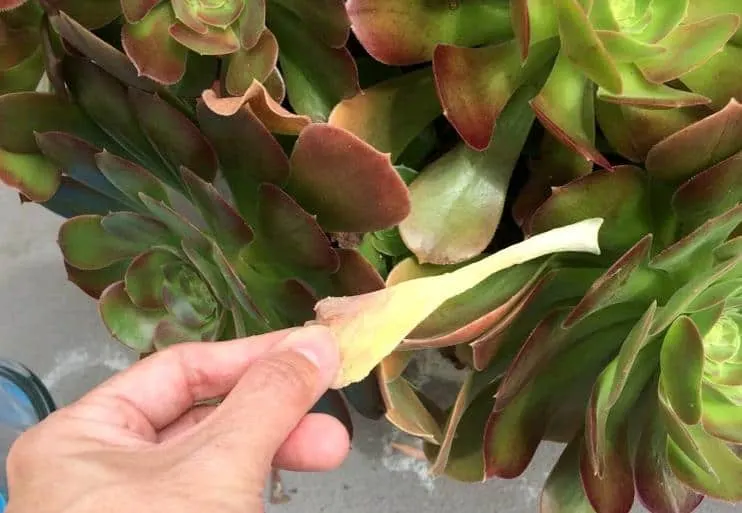

Remedy: Pull off any dead leaves from the plant or remove dead leaves that have fallen off into the soil to prevent insects and bugs from hiding in there.
Stems Stretching Out
Stems stretch out or the entire plant starts stretching out or etiolate if the plant does not receive enough light. Etiolation is a plant’s natural response to lack of light.
The stem and the plant itself are stretching out towards the direction of the light source. You may notice the stem stretching out and the spaces in between the leaves get wider. The plant’s growth tends to be weakened when in this state.
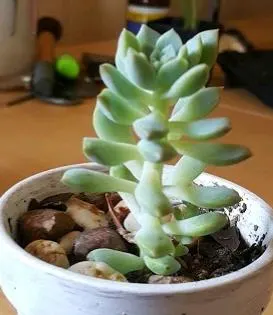
Remedy: Move your plant to a brighter location. A south or east facing window will provide the most sunlight indoors. Slowly acclimate your plant if moving it to a sunnier location to avoid sun damage.
Avoid sudden changes that may shock your plant. For example, try not to move the plant from a low light setting indoors to full sun outdoors right away. Slowly increase the amount and intensity of sunlight the plant receives.
If you are unable to provide more sunlight for your indoor succulents, a grow light is a great option to provide more light for those hard to reach areas indoors. Watch how your plant reacts when moving to a different location or when using a grow light, or when making any sort of adjustments. Adjust and make changes as needed.
Misshapen Leaves
Watering Issues
Leaves can become misshapen from watering issues mentioned above. Either the plant is receiving too little or too much water. Too little and the leaves start to shrivel. Too much water and the leaves become soggy and soft and may also wrinkle.
Lack of nutrients
Another common reason is lack of nutrients in your plants. If your plant has been in the same pot and has not been re-potted for over two years or longer, the potting mix its in might be depleted of nutrients for your plants. If this is the case, the leaves will sometimes turn yellow or discolor and also start appearing misshapen.
Most commercial succulent potting soil come with added compost or fertilizer in the mix. The plants can feed on those nutrients for quite some time. Eventually these nutrients are flushed out of the soil from constant watering and nutrients need to be added back in.
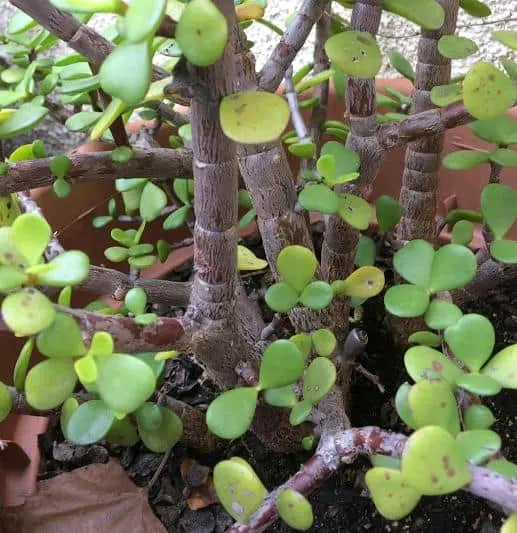
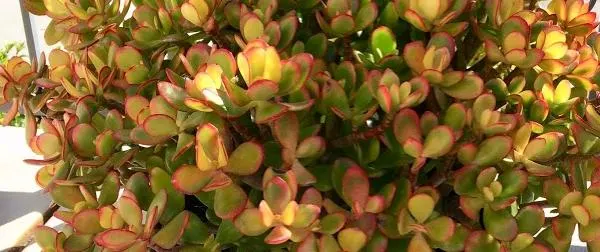
These plants are suffering from lack of nutrients. Their leaves are discoloring and misshapen.
Remedy: If you suspect watering issues might be the cause of misshapen leaves, adjust watering techniques and see how your plant responds. If the plant is underwatered and the leaves are shriveled, a good watering will often quickly solve the problem.
If the plant is overwatered, it depends on the extent of the damage to the plant how your plant reacts when water is withheld. The plant may quickly recover but if not, you may need to switch out the soil your plant is sitting in or there might already be root rot.
If it’s lack of nutrients that’s causing misshapen leaves, re-pot the plant using a suitable well draining potting mix or by fertilizing. Nutrients can be added in by re-potting the plant in fresh potting mix or by fertilizing the plant. Use a well balanced fertilizer designed for houseplants or a fertilizer blend specifically formulated for cacti and succulents.
Cacti and succulents are not heavy feeders and do not require a lot of fertilizers. Dilute the amount of fertilizer recommended on the package to half. Feeding about every two weeks during the growing season should be good enough.
Stunted Growth
Stunted growth can be caused by lack of light. Plants that do not receive adequate sunlight become weak and will not grow properly. The stems start stretching out and new growth will be sparse and minimal.
Remedy: Move your plant to a brighter location. A south or east facing window will provide the most sunlight indoors. Slowly acclimate your plant if moving it to a sunnier location to avoid sun damage. Avoid sudden changes that may shock your plant.
For example, try not to move the plant from a low light setting indoors to full sun outdoors right away. Slowly increase the amount and intensity of sunlight the plant receives. Watch how your plant reacts when moving to a different location, and adjust as needed.
Lack of nutrients may also cause stunted growth. If your plant has been sitting in the same pot for over two years, it may be time to re-pot or add nutrients. Most commercial succulent potting soil come with added compost or fertilizer in the mix.
The plants can feed on those nutrients for quite some time. Eventually these nutrients are flushed out of the soil from constant watering and nutrients need to be added back in.
Remedy: Re-pot the plant using a suitable well draining potting mix or by fertilizing. Nutrients can be added in by re-potting the plant in fresh potting mix or by fertilizing the plant. Use a well balanced fertilizer designed for houseplants or a fertilizer blend specifically formulated for cacti and succulents.
Cacti and succulents are not heavy feeders and do not require a lot of fertilizers. Dilute the amount of fertilizer recommended on the package to half. Feeding about every two weeks during the growing season should be good enough.
Can my succulent be saved?
We’ve all done it. You think you killed your plant. You feel terrible for killing your baby. Can your plant be saved or is it lost forever? It really depends on the extent of the damage to the plant.
The best way to tell is to examine the entire plant all the way to its roots. If you see enough viable roots, your plant may have a chance. But if the roots have rotted, turned black, or have dried up and turned brown, chances are slimmer that you can save your plant.
Also, examine different parts of your plant. If your plant has succumbed to root rot but you see some parts of the plant are still firm and not mushy, you might still be able to save the plant by cutting off the mushy, tender parts and letting the part that still looks good dry and heal for a few days, then wait to see if it grows roots.
Weirder things have happened to my plants. Often, when I think I have killed a plant it miraculously comes back and survives. Succulents and cacti are amazing, resilient plants. When given a chance, they can survive and thrive the harshest conditions.
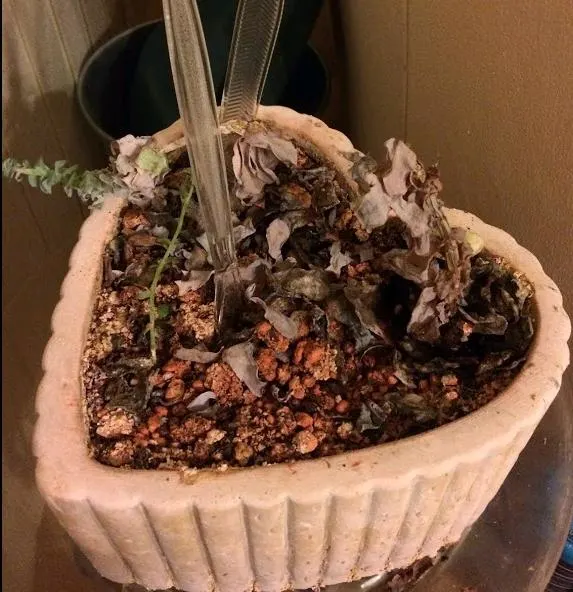
Here is a succulent arrangement that suffered a sad, sad fate. I can almost hear the sad music in the background. I sent this once beautiful arrangement to my mother as a Mother’s Day gift two years ago.
I found the planter in this sorry state when I visited her this year. Sadly, she didn’t even know she killed the plants in it. She lives in a humid climate with very cold, freezing winters so she had this arrangement indoors.
The plants were overwatered and did not receive enough light. The poor plants did not stand a chance. This unfortunately, cannot be saved. I can tell the plants have rotted all the way to the roots without even taking the plants apart.
There may be times when you feel like you have tried everything and the plants are still not perking up. The problem may be hiding under the leaves and in the soil. If your plants are looking sick and upon closer inspection you see tiny bugs crawling and creeping around, then you might have a pest infestation. Click here for tips and suggestions.
Pin this to save for later or share with others now!
